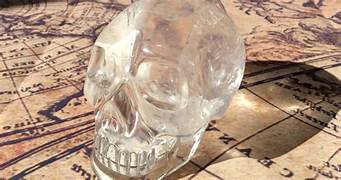Key Moments In Crystal Skulls History
In The Last 300 Years
The history of crystal skulls remains somewhat of a mystery, but new information keeps coming to light. Crystal Skull Explorer Joshua Shapiro provides the following crystal skull history timeline as recorded in his 2004-5 Crystal Skull Explorers ebook
18th Century
Early 1700’s : A Monk near Luv, Russia, while taking his daily walk notices a large rose quartz skull sticking out of a mound. Contained within this mound are a number of artifacts that are linked to the ancient Scythians, a people who lived in Russia over 1000 years ago. (Author’s Note: This is one of the skulls that is in the hands of Ms. Joky van Dieten, called the “Luv” skull).
Late 1700’s: A blind craftsman works with a local Shaman in the Amazon to fashion a human-size crystal skull from a large block of quartz. It is perceived that some spiritual entity of unknown origin is present within this skull. (Author’s Note: this skull becomes known “Windsong”, the caretaker is Floyd Petri).
19th Century
1840’s: The Redo family acquires a small crystal skull that includes a Christian Cross made from Gold and Quartz. This Cross is inserted into a circular opening at the top of the skull. The Crystal Cross shows a date of 1571 that is engraved upon it. The family received this skull either through a local Church or it was purchased.
1860’s-1880’s: Eugéne Boban works in Mexico (1862-1867) during the French Occupation and is appointed as the French Scientific Commission underneath Emperor Maximillan. It is suspected that at this time he begins to acquire some crystal skulls either found in various Mesoamerican ruins or has contacts with local skilled carvers. It is believed that the two crystal skulls that became known as the Paris and British Museum Crystal Skulls (in the Musèe de l’homme located in Paris and the British Museum in London) were acquired by Boban and were eventually sold to various individuals later during this period.
1876-1910: It is reported that President Porfirio Diaz of Mexico has a collection of crystal skulls on his desk. Two of the skulls that are purportedly a part of his collection are claimed to be an amethyst crystal skull (later to be known as ”Ami”) and possibly a large hollow Crystal Skull that was later sent to the Smithsonian Institute in Washington D.C. in 1995.
1878: Alphonse Pinart donates a clear crystal skull to Musèe de l’homme (Trocadero Museum) in Paris. He reports that he purchased this skull through Eugéne Boban.
1881: Inside of Boban’s catalogue of goods for sale for this year, he lists a human-size crystal skull (it is suspected that this is the British Museum Crystal Skull).
1886: A Mr. Ellis is reported in a New York City newspaper to have bought a large crystal skull from Boban. (Again suspected to be the British Museum Crystal Skull)
1890: In a book published by George Frederick Kunz, Gems and Precious Stones , he mentions both the Paris and British Museum Crystal Skulls. It is the first time a crystal skull is seriously discussed in a published book. This book states that a Mr. George Sission of New York City is in possession of a human size crystal skull (is this the British Museum Skull?).


Leave a Reply